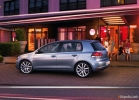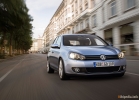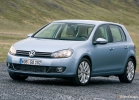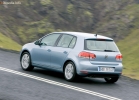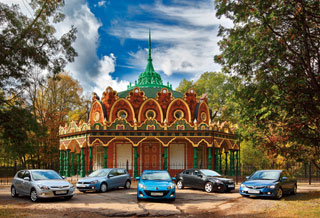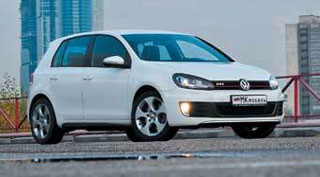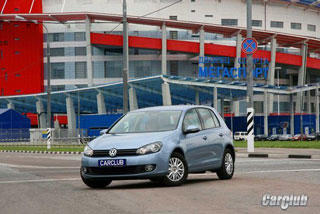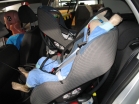Volkswagen Golf VI test drive 5 doors since 2008 Hatchback
Great Variant
 Since his debut in 1974, VW Golf instantly won the hearts and minds of millions of people in all parts of the world.
Since his debut in 1974, VW Golf instantly won the hearts and minds of millions of people in all parts of the world. His name is a whole class of compact city cars. From generation to generation, the model was improved, its technical part was complicated. So how did Golf 4 have established itself in Russian conditions?
The model was launched in production in September 1997, and despite the fact that a great resemblance to Golf 3 was visible, Golf 4 was not a deep restyling, but an independent model built on the new A4 platform, on which the concern produced such vehicles as VW News Beetle, Skoda Octavia, Audi A3, Audi TT, Seat Leon, Seat Toledo. The fourth had many common nodes and assemblies with them.
The fourth -generation Golf family is quite diverse. Actually, Golf 4 itself was produced as a three- and five-door hatchback. The station wagon, which went on sale in May 1999, was traditionally called Golf Variant. The sedan, which stood on the conveyor in September 1998, was named Bora (for the American Jetta market) and was distinguished by other external body details. Bora Variant differed from the Golf Variant elements of the front of the body. And Golf Cabrio was, in fact, the previous model, that is, Golf 3, who had undergone development in the Golf 4 style.
The basic equipment could boast of at least two airbags, seat belts with pyrotechnic tensioners, ABS, electric windows and mirrors. In addition to the base, three main packages were also presented: Comfortline, Trendline and Highline. Since September 1999, it was possible to order an ESP exchange rate system. On later options, quite often you can find not only side airbags placed in the backs of the front seats, but also window. As a result, one of the best indicators in the passenger safety class.
A wide range of engines opens a 1.4 -liter motor and a capacity of 75 hp. Fans to ride with a breeze this unit is clearly not suitable. In order not to get out of the stream, it constantly has to twist it, which, accordingly, affects the resource. Following it is a 8-valve 1.6-liter engine with a capacity of 100 hp. and a 105-horsepower version with 16 valves. These motors are the most common for Golf 4, they are also recognized as the most successful. The engine can pass without serious interventions of more than 300,000 km. The main thing is to change the oil in time, monitor its level and not overheat the motor. Of the characteristic sores, it is worth highlighting the leak of antifreeze through the cracked plastic pipes of the cooling system and the thermostat case.
With the same litter, a FSI motor with a capacity of 110 hp was also produced. It has direct injection and is not very adapted to our operating conditions. The main problems of this engine in Russia are fuel equipment, which often fails due to poor-quality gasoline, and the cost of eliminating problems is much higher than on distributed injection engines.
The engine with a volume of 1.8 liters is presented in two versions: the atmospheric issued 125 hp, and the turbocharged version 150 and 180 hp. The hopeless version can claim the role of a rather dynamic machine, especially with a mechanical gearbox. With a turbine, a pretty light Golf accelerates a little more than 8 seconds to hundreds. But the risk of buying a turbocharged version is quite large (the price of a new turbine is about $ 1000), and there are such copies in a decent state not cheap. After all, the owners of turbo leaders were, as a rule, far from pensioners. The main rule during the operation of these engines do not jerk the engine after a dynamic driving, thus allowing to cool the turbine. Better yet, immediately install a turbotimer. Well, more often to replace the oil.
A 2 liter engine (115 hp) is quite unpretentious and reliable. Especially if you do not forget about the replacement of the timing belt and the pump every 90,000 km. Motors V5 2.3 (150 hp), VR5 2.3 (170 hp), V6 2.8 (204 hp) and VR6 3.2 (240 hp) are endowed with Golf 4 excellent dynamics and pleasure from driving. But you have to pay for pleasure. These power units are more complex and roads in repair, although they have a pretty decent resource. They appear on sale, as a rule, when the time comes for serious repairs.
There were diesel versions in the model range. All with a volume of 1.9 liters. The weakest SDI atmospheric had only 68 hp, and the TDI 90, 101, 110, 115, 130, 150 hp versions. These units are equipped with a pump fund, have an enviable resource, efficiency and environmental friendliness. But all this is achieved when using high -quality fuel, which is not yet in Russia. It makes sense to take a diesel if the motor is in excellent condition, with a little mileage and the future owner plans large annual runs.
Golf 4 offered 5- and 6-speed mechanical gearboxes and 4- and 5-speed automatic transmission. The latter could boast of manual speed switching. All boxes are quite reliable. On a mechanical KP, a gear lever sometimes spans. This is treated in most cases by replacing the switching mechanism (about $ 160 with work). On many boxes with a 1.6 -liter engine, a difficult inclusion of the first gear is often observed. It is recommended to change the oil in mechanics every 90,000 km, and the clutch replacement depends on the driving style and experience sitting at the wheel. The average indicators are 120,000200,000 km.
In machine guns, you must change the oil every 60,000 km, and pour only the recommended by the plant. But there are nuances here. When buying, you need to find out from the seller with what frequency he changed the oil in the automatic transmission. It is not completely replaced, but partially, since the new in most cases, having high detergents, dissolves old deposits and disables the box. If the car mileage is large, the oil did not change, and the box works properly, then it is better not to change. Many specialized services generally say that the oil is flooded for the entire service life.
Starting with a 1.8-liter engine, it was optionally possible to order a 4 Motion all-wheel drive. In versions with a 2.8 -liter engine and R32, it was already in the basic configuration. The all -wheel drive makes Golf 4 extremely stable on a slippery road and gives an unforgettable impressions of driving. The reverse side of these modifications is the complexity of service and the high cost of spare parts relating to all -wheel drive elements. In addition, such devices are taken by the first owner not for trips to the bakery, and in the secondary market they appear, as a rule, either strongly worn or very expensive.
The Golf 4 body without exaggeration can be called the reference in its class. Thanks to galvanizing, the manufacturer gives a 12-year guarantee from through corrosion. Chips of paint to metal, surviving several Moscow winters, do not give a reason for the appearance of rust. All body panels are fitted perfectly, and the gaps between the elements are minimal. As a result, the almost complete absence of aerodynamic noise at any speed. So if you have a car with traces of corrosion, then most likely it visited an accident and was poorly restored. The only disadvantage is the fruits of the doors in the openings when the temperature moves through 0 C. The manufacturer even released a special lubricant, which slightly facilitated the penetration into the salon, which is strict and comfortable for its class in German. Many adjustments allows you to find the right position driving a driver of any height. The central console a la BMW is deployed towards the driver. Of the ergonomic miscalculations, the inconvenience of using a climate installation. It is out of sight of the driver, you have to be distracted by the buttons while moving. In the trim levels with the mechanical control of climate, there is no such problem.
An electrician does not cause much trouble. Although the rear wiper motor often fails. The front wiper trapezoid may acidify. Many try to lubricate it, but it either does not help or help temporarily (it is treated to replace a trapezoid of an average of $ 100 with work). The STOP-signal switch, located in the pedal node, can also fail. Often before failure, it lights various control lamps on the dashboard related to stabilization and braking systems, but it works. With a complete breakdown, braking signals go out. In the presence of automatic transmission, in addition to the footsteps, the box selector is blocked and the car is immobilized. In order not to call the tow truck, you can try to throw off the chip from the switch, most likely the selector is unlocked. The cost of the switch is $ 15, the replacement work $ 10. On cars produced until mid -2001, wiper defects were often observed.
The chassis of the majority Golf 4 has a simple design, it is reliable, inexpensive in maintenance and is quite comfortable for its class. The front suspension is MacPherson, and there could be options in the back. On the front-wheel drive versions, a simple N-shaped beam was used, and if there was a full-wheel drive, a multi-leaf suspension was installed, complicating and increasing costs. The wear of the suspension directly depends on the driving style and the speed of passing the pits. The first to make themselves to feel the racks and bushings of the stabilizer on average every 50,00060,000 km. But the cost of spare parts and work penny is about $ 60 for everything. With active driving to 150,000 km, shock absorbers can die ($ 150 with work). The remaining elements of the suspension on average serve more than 100,000 km. The front pads (depending on the driving style) go 20,00030,000 km, and the wheels are 80,00090,000. The rear pads live about 60,00070,000 km.
The prices for Golf in decent state begin on average from 250,000 rubles for a 1998 car with a 1.4-liter engine in the basic configuration and end around the mark of 450,000 rubles for the apparatus of the late 2003, which is in excellent condition, equipped with 2-liter motor, automatic transmission and a mass of additional options.
EXCURSION
The first generation VW Golf saw the light in the summer of 1974. The car got its name in honor of the warm ocean course. It was equipped with engines with a volume of 1.1 to 1.8 liters (50112 hp). Along with mechanics, automatic transmission was proposed. The 3- and 5-door hatchback, sedan and convertible was presented in bodies. He had a rare front -wheel drive at that time. 6.8 million pieces were produced.
In August 1983, Golf 2 was represented, which retained the main proportions of the previous model. The car has become wider and longer. He had motors from 1.0 to 1.8 liters (45160 hp). Optionally, Syncro all -wheel drive was offered. The version of Country, in addition to all -wheel drive, had an enlarged road clearance, a spar frame and a lowering gear. 6.3 million pieces were produced.
In August 1991, the third generation appeared. Under the hood, motors with a volume of 1.4 to 2.9 liters (55190 hp) were installed under the hood. Roll hydraulic power in the basic configuration. Significantly increased the safety of passengers in an accident using an enhanced frame with energy -absorbing zones and a traumatic steering column. The first car in its class with mass -installed airbags for the driver and front passenger and ABS. In total, 4.8 million cars were produced.
From 1997 to 2003, 4.3 million fourth Golf were released.
Golf 5 was presented in September 2003. The car received new engines with direct fuel injection and the rear multi -link suspension. The new body has become more spacious, its rigidity is increased. Gamma of engines from 1.4 to 3.2 liters (75250 hp). New DSG boxes. Bas, ESP are serial.
In 2008, the light saw Golf 6. Although the car was built on the fifth Golf platform, it has practically no common details with it.
The fourth -generation VW Golf retained all the advantages of its ancestors, adding comfort and significantly increasing active and passive safety, which somewhat complicated the side electronics, which sometimes fails. Otherwise, high reliability and excellent maintenance, combined with democratic prices for spare parts, make a car one of the best options in the class for purchase in the secondary market.
FITTING
Presented in the photographs of the Volkswagen Golf 4 Variant 1,6 of 2003 release with a mileage of 119,000 km has been in Russia since 2008 and during this time has changed two owners. The current owner has less than a year.
Before buying, a comprehensive examination of the car was carried out, which confirmed the excellent condition and the lack of painted parts. Motor wear at the time of the check is about 20% (with a mileage of 115,000 km). It was required to replace the cracked crankcase ventilation hose and eliminate the thermostat leak.
The owner is satisfied with the car and in the near future is not going to change it.
Similar options that are in a decent state are sold today at a price of 350,000,000,000 rubles.
How much costs ($)
Regulatory work
Replacing oil and filter in the engine (every 10 thousand km) - 100
Air filter - 20
Fuel filter - 20
Oil replacement in automatic transmission - 120
Set of spark plugs - 50
Brake fluid replacement - 50
Timing set - 170
Repair
Replacing pads (front/rear) - 20/30
Replacing the hub bearing
(front/rear) - 50/50
Business pump replacement - 70
Turbine replacement - 150
Spare parts
Front pads - 3590
Brake front disk - 60
Front shock absorber - 70150
Hub bearing (before./Rear) - 70/50
Expande tank - 20
Turbine - 1000
Winter trapezoid - 60
Source: MKOMBILA magazine [July/2010]
VOLKSWAGEN GOLF VI Test Drive Video 5 doors since 2008
VOLKSWAGEN GOLF VI 5 doors since 2008
Volkswagen Golf VI Test Drive 5 doors since 2008
VOLKSWAGEN GOLF VI Crash Test 5 doors since 2008
Krassh Test: Detailed Information36%
Driver and passengers
22%
Pedestrians
41%
Children-passengers

